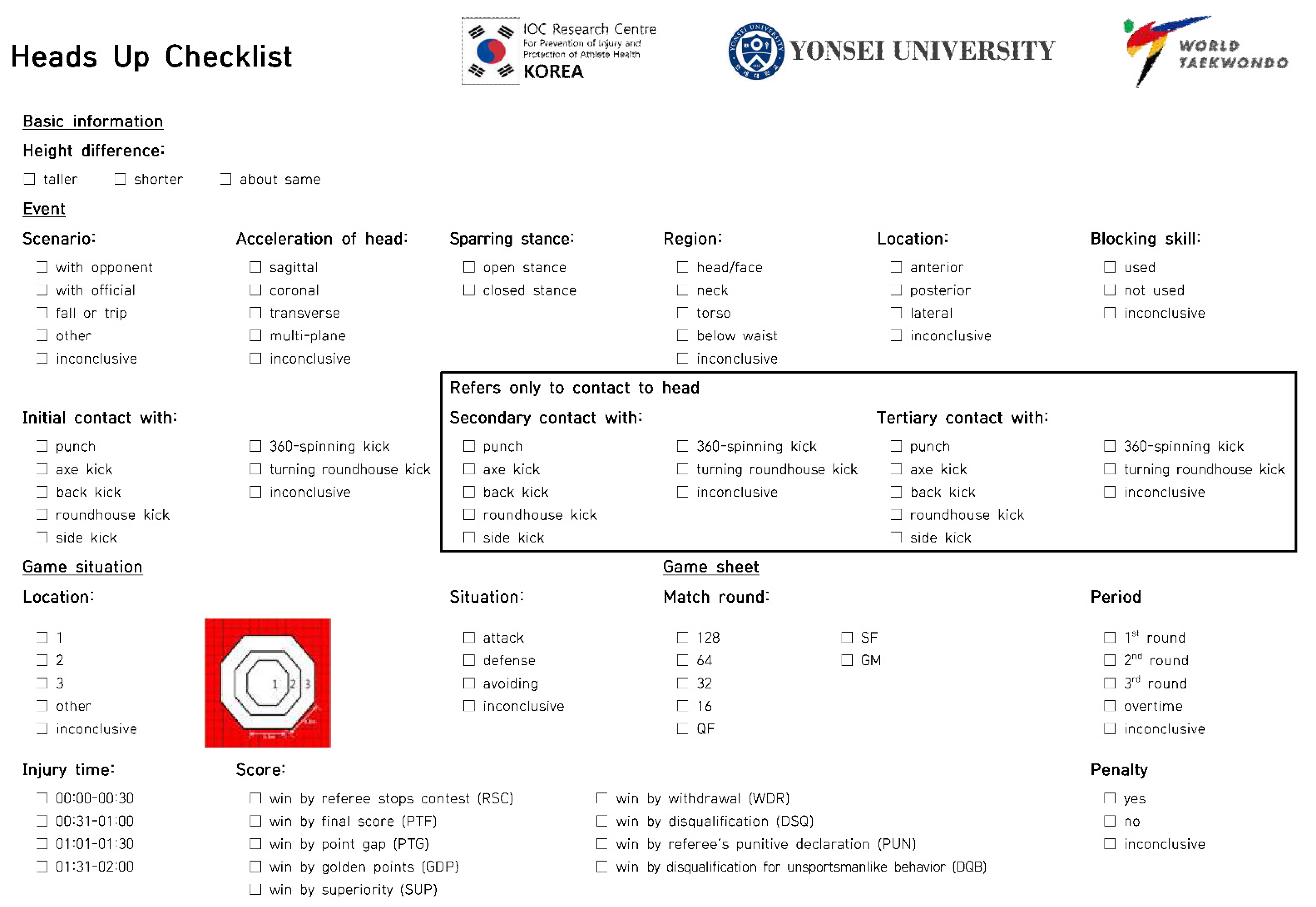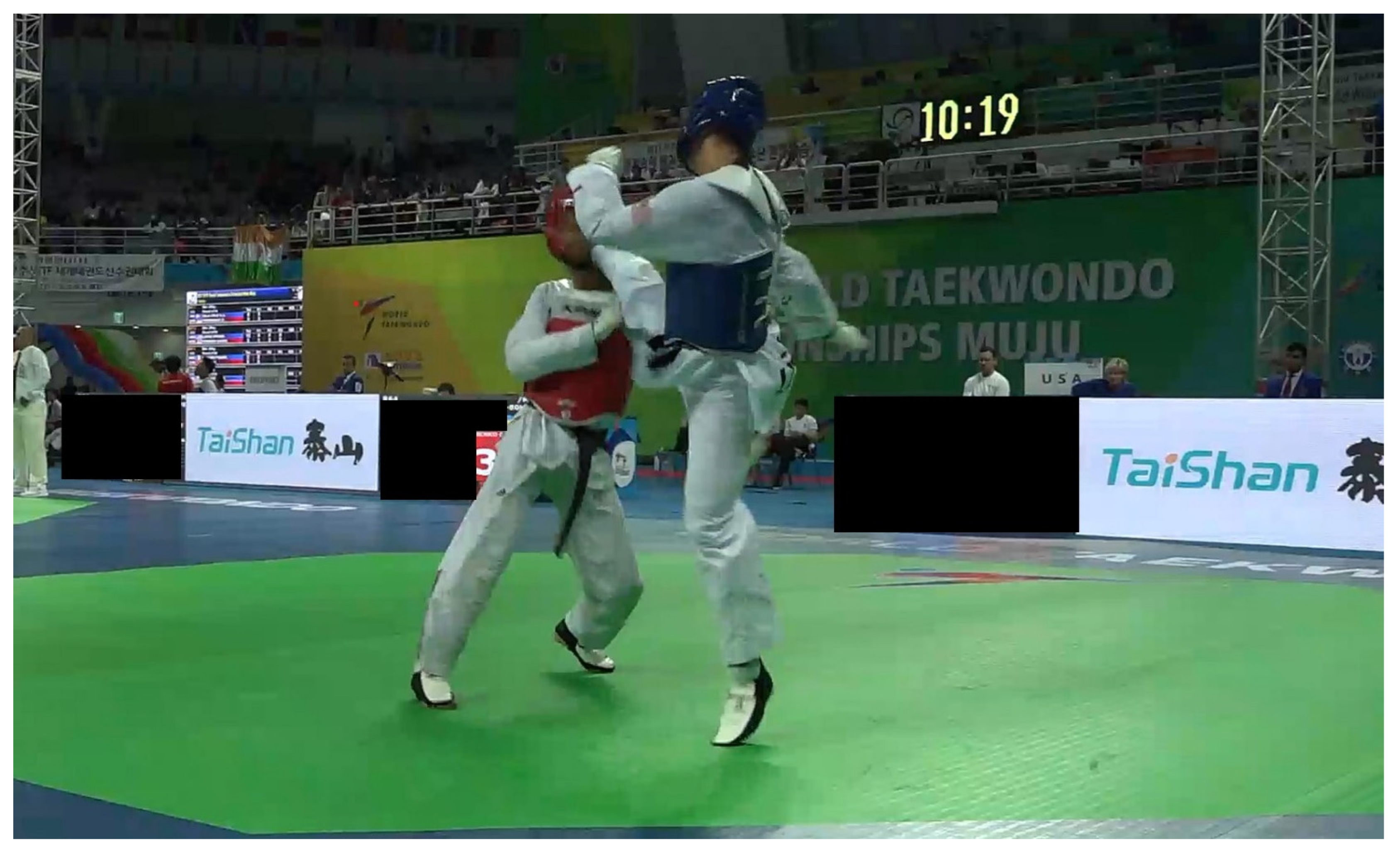Mechanisms of Sports Concussion in Taekwondo: A Systematic Video Analysis of Seven Cases
Abstract
:1. Introduction
2. Materials and Methods
2.1. Overview
2.2. Concussion Data Collection
2.3. Concussion Definition
2.4. Video Analysis
2.5. Statistical Analysis
3. Results
3.1. Incidence Rate of Concussion
3.2. Situation of Concussion
4. Discussion
4.1. Bias in Estimating the Incidence of Concussion
4.2. Low-Quality Blocking Technique
4.3. Protective Equipment: Headguards
4.4. Concussion Preventive Education
5. Conclusions
Author Contributions
Funding
Institutional Review Board Statement
Informed Consent Statement
Data Availability Statement
Acknowledgments
Conflicts of Interest
References
- Worldtaekwondo. Competition Rules & Interpretation. 2019. Available online: http://www.worldtaekwondo.org/wp-content/uploads/2019/08/WT-Competition-Rules-Interpretation-Manchester-May-15-2019.pdf (accessed on 14 May 2019).
- Koh, J.O.; Voaklander, D. Effects of competition rule changes on the incidence of head kicks and possible concussions in Taekwondo. Clin. J. Sport Med. 2016, 26, 239–244. [Google Scholar]
- McCrory, P.; Meeuwisse, W.; Dvořák, J.; Aubry, M.; Bailes, J.; Broglio, S.; Cantu, R.C.; Cassidy, D.; Echemendia, R.J.; Castellani, R.J.; et al. Consensus statement on concussion in sport-the 5th international conference on concussion in sport held in Berlin, October 2016. Br. J. Sports Med. 2017, 51, 838–847. [Google Scholar] [PubMed]
- Lystad, R.P. Concussion injury in Olympic-style Taekwondo: A systematic review. J. Int. Assoc. Taekwondo Res. 2014, 1, 1–11. [Google Scholar]
- Emery, C.A.; Black, A.; Kolstad, A.; Martinez, G.; Nettel-Aguirre, A.; Engebretsen, L.; Johnston, K.; Kissick, J.; Maddocks, D.; Tator, C.; et al. What strategies can be used to effectively reduce the risk of concussion in sport? A systematic review. Br. J. Sports Med. 2017, 51, 978–984. [Google Scholar] [CrossRef] [PubMed]
- Hendricks, S.; O’Connor, S.; Lambert, M.; Brown, J.C.; Burger, N.; Mc Fie, S.; Readhead, C.; Viljoen, W. Video analysis of concussion injury mechanism in under-18 rugby. BMJ Open Sport Exerc. Med. 2016, 2, e000053. [Google Scholar] [CrossRef] [PubMed]
- Hutchison, M.G.; Comper, P.; Meeuwisse, W.H.; Echemendia, R. A systematic video analysis of National Hockey League (NHL) concussions, part I: Who, when, where and what? Br. J. Sports Med. 2013, 49, 547–551. [Google Scholar] [CrossRef]
- Hutchison, M.G.; Comper, P.; Meeuwisse, W.H.; Echemendia, R.J. A systematic video analysis of National Hockey League (NHL) concussions, part II: How concussions occur in the NHL. Br. J. Sports Med. 2013, 49, 552–555. [Google Scholar] [CrossRef]
- Koh, J.O.; Watkinson, E.J. Video analysis of blows to the head and face at the 1999 World Taekwondo Championships. J. Sports Med. Phys. Fit. 2002, 42, 348. [Google Scholar]
- Koh, J.O.; Watkinson, E.J.; Yoon, Y.-J. Video analysis of head blows leading to concussion in competition Taekwondo. Brain Inj. 2004, 18, 1287–1296. [Google Scholar] [CrossRef]
- Thomas, R.E.; Thomas, B.C.; Vaska, M.M. Injuries in taekwondo: Systematic review. Phys. Sportsmed. 2017, 45, 372–390. [Google Scholar] [CrossRef]
- Guskiewicz, K.M.; Marshall, S.W.; Bailes, J.; McCrea, M.; Cantu, R.C.; Randolph, C. Association between recurrent concussion and late-life cognitive impairment in retired professional football players. Neurosurgery 2005, 57, 719–726. [Google Scholar] [CrossRef] [PubMed]
- Matser, J.; Kessels, A.; Lezak, M.; Troost, J. A Dose-Response Relation of Headers and Concussions With Cognitive Impairment in Professional Soccer Players. J. Clin. Exp. Neuropsychol. 2001, 23, 770–774. [Google Scholar] [CrossRef] [PubMed]
- Pearce, N.; Gallo, V.; McElvenny, D. Head trauma in sport and neurodegenerative disease: An issue whose time has come? Neurobiol. Aging 2015, 36, 1383–1389. [Google Scholar] [CrossRef] [PubMed]
- Worldtaekwondo. Explanation on the Use of Medical Forms. 2020. Available online: http://www.worldtaekwondo.org/medical-anti-doping/medical/forms/Taekwondo (accessed on 7 April 2020).
- Hutchison, M.G.; Comper, P.; Meeuwisse, W.H.; Echemendia, R.J. An observational method to code concussions in the National Hockey League (NHL): The heads-up checklist. Br. J. Sports Med. 2013, 48, 125–129. [Google Scholar] [CrossRef]
- Charmant. Kinovea, 0.8.27 version; [Computer software]. 2018. Available online: http://www.kinovea.org/ (accessed on 1 March 2020).
- Nichols, T.R.; Wisner, P.M.; Cripe, G.; Gulabchand, L. Putting the Kappa Statistic to Use. Qual. Assur. J. 2010, 13, 57–61. [Google Scholar] [CrossRef]
- Landis, J.R.; Koch, G.G. The Measurement of Observer Agreement for Categorical Data. Biometrics 1977, 33, 159–174. [Google Scholar] [CrossRef]
- Soligard, T.; Steffen, K.; Palmer-Green, D.; Aubry, M.; Grant, M.-E.; Meeuwisse, W.; Mountjoy, M.; Budgett, R.; Engebretsen, L. Sports injuries and illnesses in the Sochi 2014 Olympic Winter Games. Br. J. Sports Med. 2015, 49, 441–447. [Google Scholar] [CrossRef]
- Oler, M.; Tomson, W.; Pepe, H.; Yoon, D.; Branoff, R.; Branch, J. Morbidity and mortality in the martial arts: A warning. J. Trauma 1991, 31, 251–253. [Google Scholar] [CrossRef]
- Beidler, E.; Wallace, J.; Alghwiri, A.A.; O’Connor, S. Collegiate athletes’ concussion awareness, understanding, and-reporting behaviors in different countries with varying concussion publicity. J. Athl. Train. 2021, 56, 77–84. [Google Scholar] [CrossRef]
- Koh, J.O.; Cassidy, J.D. Incidence Study of Head Blows and Concussions in Competition Taekwondo. Clin. J. Sport Med. 2004, 14, 72–79. [Google Scholar] [CrossRef]
- Ziaee, V.; Rahmani, S.H.; Rostami, M. Injury rates in Iranian taekwondo athletes; A prospective study. Asian J. Sports Med. 2010, 1, 23–28. [Google Scholar] [CrossRef] [PubMed]
- Pieter, W.; Fife, G.P.; O’Sullivan, D.M. Competition injuries in taekwondo: A literature review and suggestions for prevention and surveillance. Br. J. Sports Med. 2012, 46, 485–491. [Google Scholar] [CrossRef] [PubMed]
- McIntosh, A.S.; A Patton, D. The impact performance of headguards for combat sports. Br. J. Sports Med. 2015, 49, 1113–1117. [Google Scholar] [CrossRef] [PubMed]
- Rowson, S.; Duma, S.M. Brain Injury Prediction: Assessing the Combined Probability of Concussion Using Linear and Rotational Head Acceleration. Ann. Biomed. Eng. 2013, 41, 873–882. [Google Scholar] [CrossRef]
- O’Sullivan, D.M.; Fife, G.P. Biomechanical head impact characteristics during sparring practice sessions in high school taekwondo athletes. J. Neurosurgery: Pediatr. 2017, 19, 662–667. [Google Scholar] [CrossRef] [PubMed]
- Jayarao, M.; Chin, L.S.; Cantu, R.C. Boxing-Related Head Injuries. Physician Sportsmed. 2010, 38, 18–26. [Google Scholar] [CrossRef]


| Variables | n (%) | Variables | n (%) | Variables | n (%) |
|---|---|---|---|---|---|
| Height Difference | Penalty (in Opponents) | Blocking Skill | |||
| Taller | 1 (14.3) | Yes | 3 (42.9) | Used | 0 (0) |
| Shorter | 4 (57.1) | No | 4 (57.1) | Not used | 6 (85.7) |
| About same | 2 (28.6) | N/A | 1 (14.3) | ||
| Scenario | Initial contact with | Situation | |||
| With opponent | 7 (100.0) | Punch | 2 (28.6) | Attack | 1 (14.3) |
| Fall or trip | 0 (0) | Axe kick | 0 (0) | Defense | 6 (85.7) |
| Other | 0 (0) | Back kick | 0 (0) | Avoiding | 0 (0) |
| Roundhouse kick | 5 (71.4) | ||||
| Side kick | 0 (0) | ||||
| 360-spinning kick | 0 (0) | ||||
| Turning roundhouse kick | 0 (0) | ||||
| Mat | 0 (0) | ||||
| Region | Secondary contact with | Period | |||
| Head | 0 (0) | Punch | 0 (0) | 1st round | 2 (28.6) |
| Face | 7 (100.0) | Axe kick | 0 (0) | 2nd round | 1 (14.3) |
| Neck | 0 (0) | Back kick | 0 (0) | 3rd round | 4 (57.1) |
| Torso | 0 (0) | Roundhouse kick | 0 (0) | Overtime | 0 (0) |
| Below waist | 0 (0) | Side kick | 0 (0) | ||
| 360-spinning kick | 0 (0) | ||||
| Turning roundhouse kick | 0 (0) | ||||
| N/A | 4 (57.1) | ||||
| Mat | 3 (42.9) | ||||
| Body location | Step | Injury time | |||
| Anterior | 4 (57.1) | Stand | 6 (85.7) | 00:00–00:30 | 1 (14.3) |
| Posterior | 0 (0) | Forward | 1 (14.3) | 00:31–01:00 | 2 (28.6) |
| Lateral | 3 (42.9) | Backward | 0 (0) | 01:01–01:30 | 1 (14.3) |
| Side | 0 (0) | 01:31–02:00 | 3 (42.9) | ||
| Acceleration of head | Sparring stance | Location in court | |||
| Sagittal | 1 (14.3) | Open stance | 2 (28.6) | 1 | 0 (0) |
| Coronal | 0 (0) | Closed stance | 5 (71.4) | 2 | 4 (57.1) |
| Transverse | 3 (42.9) | N/A | 0 (0) | 3 | 3 (42.9) |
| Multiplane | 3 (42.9) | Other | 0 (0) | ||
Publisher’s Note: MDPI stays neutral with regard to jurisdictional claims in published maps and institutional affiliations. |
© 2022 by the authors. Licensee MDPI, Basel, Switzerland. This article is an open access article distributed under the terms and conditions of the Creative Commons Attribution (CC BY) license (https://creativecommons.org/licenses/by/4.0/).
Share and Cite
Ha, S.; Kim, M.J.; Jeong, H.S.; Lee, I.; Lee, S.Y. Mechanisms of Sports Concussion in Taekwondo: A Systematic Video Analysis of Seven Cases. Int. J. Environ. Res. Public Health 2022, 19, 10312. https://doi.org/10.3390/ijerph191610312
Ha S, Kim MJ, Jeong HS, Lee I, Lee SY. Mechanisms of Sports Concussion in Taekwondo: A Systematic Video Analysis of Seven Cases. International Journal of Environmental Research and Public Health. 2022; 19(16):10312. https://doi.org/10.3390/ijerph191610312
Chicago/Turabian StyleHa, Sunghe, Min Jin Kim, Hee Seong Jeong, Inje Lee, and Sae Yong Lee. 2022. "Mechanisms of Sports Concussion in Taekwondo: A Systematic Video Analysis of Seven Cases" International Journal of Environmental Research and Public Health 19, no. 16: 10312. https://doi.org/10.3390/ijerph191610312
APA StyleHa, S., Kim, M. J., Jeong, H. S., Lee, I., & Lee, S. Y. (2022). Mechanisms of Sports Concussion in Taekwondo: A Systematic Video Analysis of Seven Cases. International Journal of Environmental Research and Public Health, 19(16), 10312. https://doi.org/10.3390/ijerph191610312






